Posts Tagged ‘metal spout’
Sunday, May 21st, 2017
This bullet-form porcelain teapot has it all: good looks, great form, a winning personality, and two different early inventive repairs. It was made in China for export during the Kangxi period (1662-1722) and is decorated with floral sprays in the Japanese Imari palette with bold colors and strong graphics. It measures 4 inches high and 6.5 inches wide from handle to spout.
At some point in its early life, a spoutless teapot was brought to a repairer who made a simple metal replacement spout. Not long after, it was brought back to be fitted for a wicker covered bronze replacement handle. A friend once showed me a similarly shaped teapot that had met such an end. And by merely sealing up the hole left by the missing spout and grinding down the handle terminals, the original owner lost a teapot but gained a sugar bowl. As much as I marvel at the ingenuity of that transformation, I am glad my broken teapot is still a teapot.





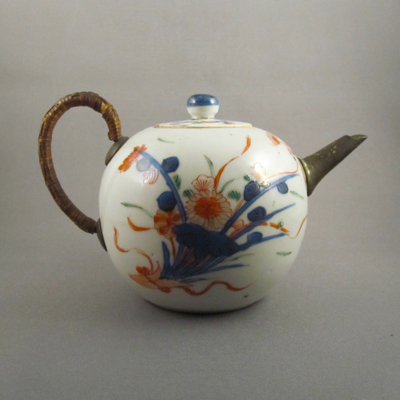


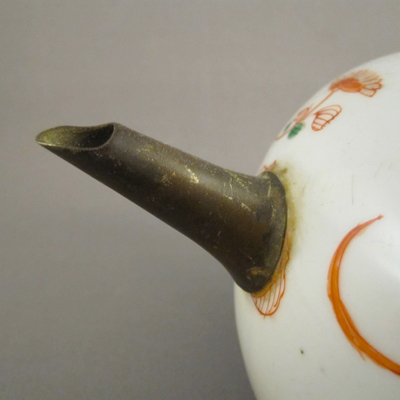
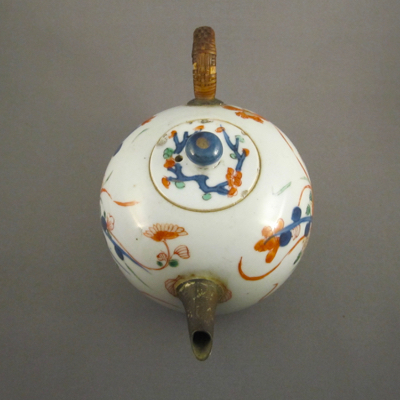
This teapot with similar form and decoration shows what the original handle and spout might have looked like on mine.
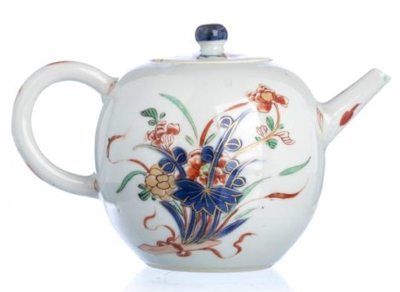
Photo courtesy of Alain Truong
Tags:Chinese, globular, Imari, metal handle, metal spout, porcelain, rattan
Posted in teapot | No Comments »
Saturday, April 15th, 2017
This basalt stoneware barrel-form teapot was made in England by Wedgwood, and in production from 1780 to 1790. It measures 3.5 inches high and 6 inches wide from handle to spout. The underside has the impressed mark “WEDGWOOD, Z, 1x”, and “B257” is hand painted in gold on the underside of the teapot and its lid.
Sadly for some but happily for me, over 200 years ago this small teapot slipped from the hands of someone who must have cherished it and the spout broke off. It was taken to a jeweler or tinker who replaced it with a silver spout on a scalloped plate. I have many examples of spouts with the same design, so I assume they were made in bulk by jewelers to have on hand, ready to be popped on to similarly damaged teapots. The lid’s knob broke off at a later date but was not replaced. I am hoping one day to make my own replacement knob of the same design, perhaps in silver to match the spout.

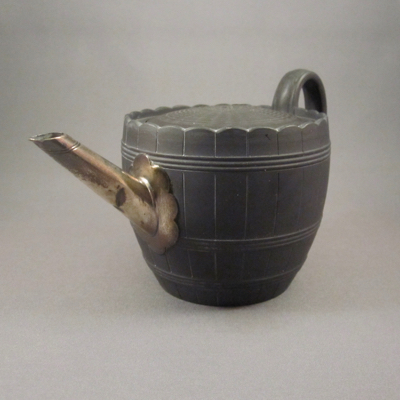

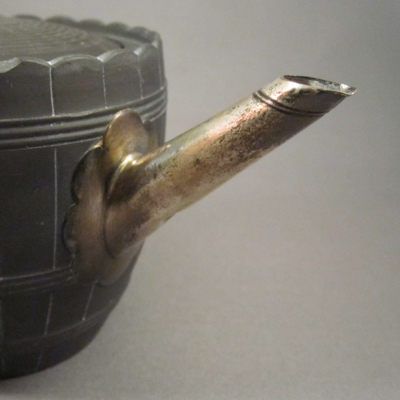
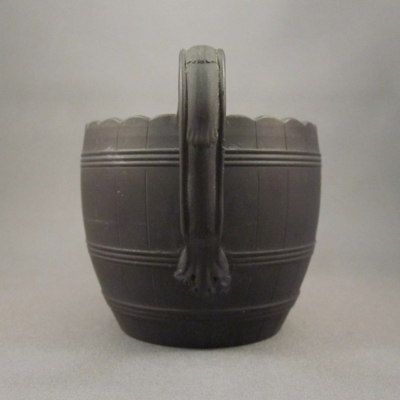
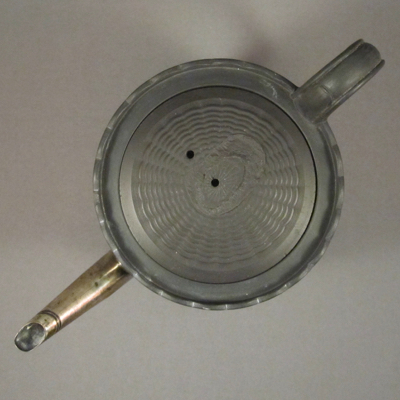

This undamaged teapot shows what the original spout and Sibyl-form knob looked like before they were damaged.

Photo from British Teapots & Tea Drinking by Robin Emmerson.
Tags:basalt, English, metal spout, silver
Posted in teapot | No Comments »
Saturday, April 1st, 2017
I love finding pieces with multiple repairs and this lovely soft paste pottery creamware teapot with pearlware glaze fits the bill nicely. It was made in Staffordshire or Leeds, England, in the late 1700s and is hand painted with spritely polychrome floral decoration on both sides. It measures 5 inches high and is marked with what appears to be A+A in red on the underside of the pot and lid.
But of course the reason it ended up in my collection is the three inventive repairs, which include a slightly exaggerated bronze handle covered in rattan, a brass collar concealing a chipped spout, and a cracked lid repaired with brown paper tape. I believe each repair was done years apart so one can only assume that the previous owners of this teapot were a clumsy lot.
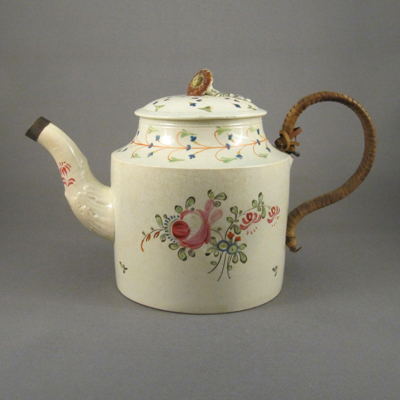

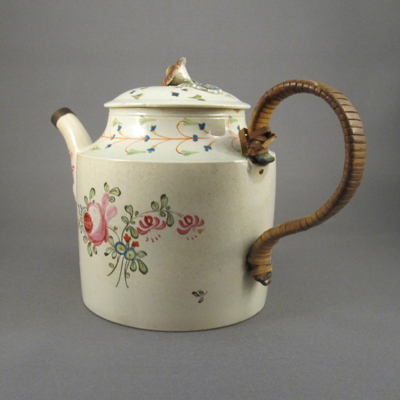
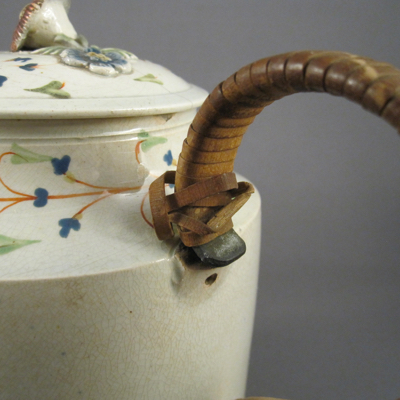

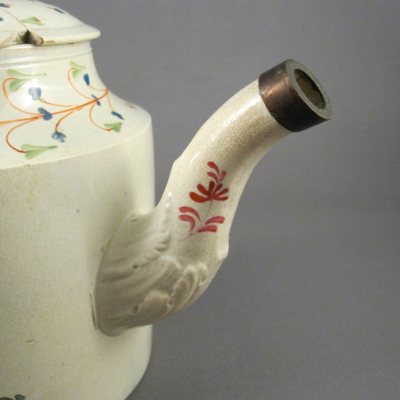
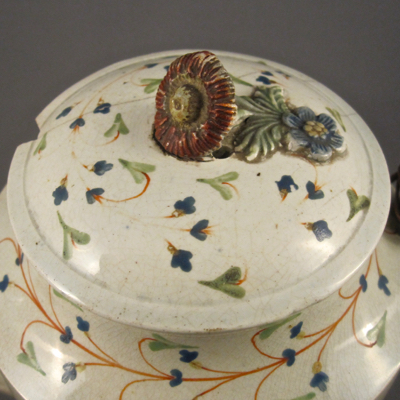



This teapot still has its original handle and spout and shows what mine may have looked like before it was repaired.
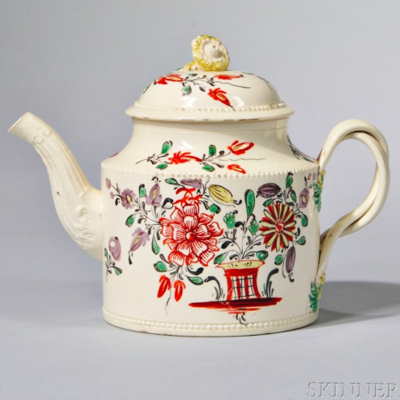
Photo courtesy of Skinner
Tags:creamware, English, metal handle, metal spout, pearlware, pottery, rattan, soft paste
Posted in teapot | 2 Comments »
Sunday, September 18th, 2016
This porcelain globular-form footed teapot was made in China in the late 1700s and is decorated in the famille rose palette with flowers, butterflies, and a diaper pattern border along the rim and on the lid. It measures 4 inches high.
A sturdy metal spout stands at attention, replacing the original porcelain one that was damaged. At a later date, a metal chain was attached to keep the lid from going astray. I have numerous metal replacement spouts just like this and feel that repairers had a stock of them on hand to be attached to damaged teapots. Look for an upcoming post where I compare and contrast similarly made replacement spouts.
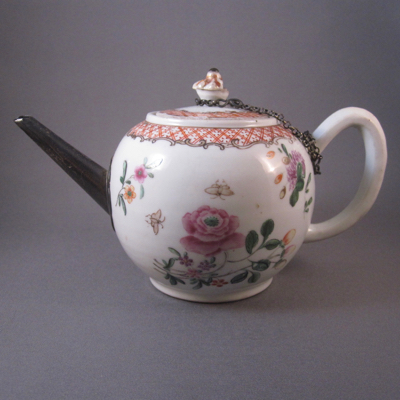
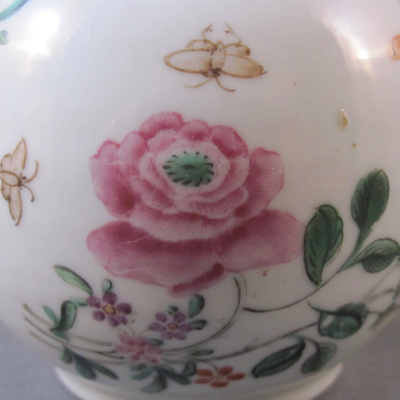
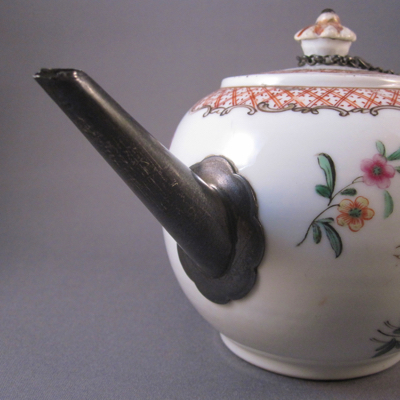
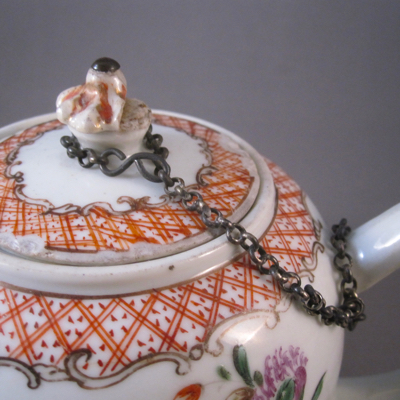

This teapot, with similar form and decoration, shows what the original spout on mine may have looked like.

Photo courtesy of 1stdibs
Tags:Chinese, metal spout, porcelain, silver
Posted in teapot | 1 Comment »
Thursday, June 23rd, 2016
This hard paste porcelain teapot was made at the Meissen factory in Germany during the Marconi Period (1763 – 1774). It measures 4.5 inches high and 8 inches from handle to spout. It is decorated in polychrome overglaze enamels with a flower motif on both sides of the pot and on top of the lid. A cobalt mark of crossed swords and a dot can be found on the underside. The noticeable surface wear suggests that it was well loved and heavily used over the past 250 years.
You can guess that this teapot found its way into my collection due to its nicely done silver replacement spout. Repairs such as this were commonly done on spouts, as they were prone to chipping. This teapot was owned by a former French teacher at my high school who lives in Brussels and has been an early supporter of this blog. Merci beaucoup, Marienne!
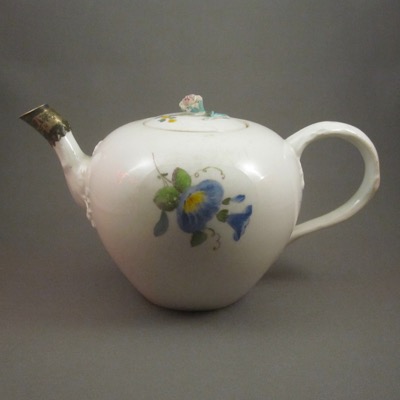
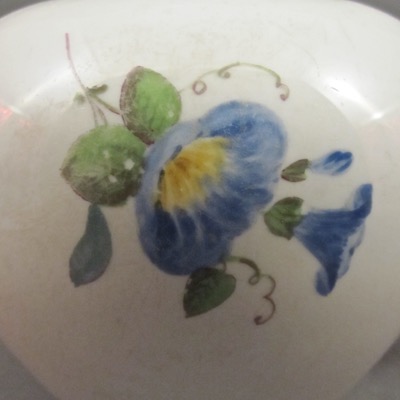
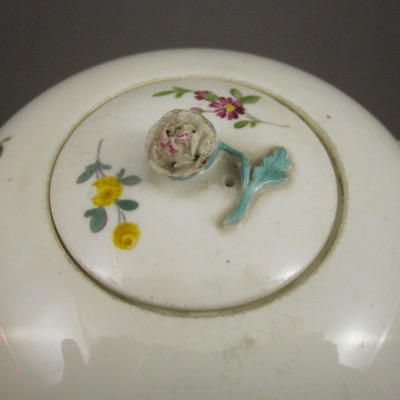
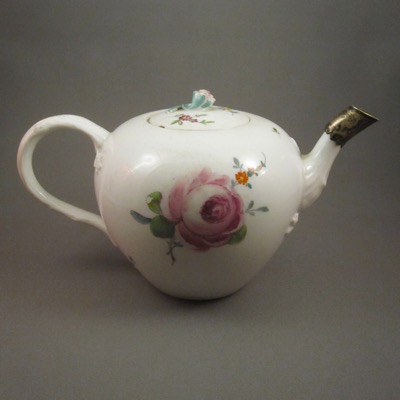

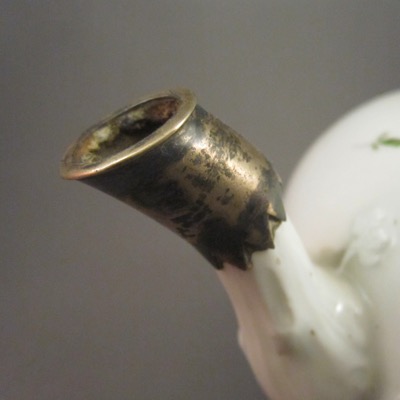


This teapot with similar form and decoration still as its original spout intact.

Photo courtesy of LiveAuctioneers
Tags:German, metal spout, porcelain, silver
Posted in teapot | No Comments »
Sunday, December 28th, 2014
This striking globular form teapot was made in China during the Qianlong period (1736-1795) for export to North America and Europe. It stands 5-1/4″ high and is decorated in cobalt underglaze with pavilions on islands in a lakeside setting.
After the original spout became damaged, the teapot was taken to a silversmith sometime in the 19th century, who replaced it with a silver Rococo style spout. I have seen many other examples of the same silver spout used on repaired teapots from the same period, so I imagine they were mass produced. In addition to the replacement spout, the broken handle has been riveted to the body and appears to be a later repair. By this point, the owner was taking no chances and chained the lid to the spout and handle to avoid further damage. On the underside is an etched signature Hood (?), but I am not sure if this was the owner of the teapot or the mender. I am hoping that it’s the latter and am on the hunt for more examples of signed ceramics.
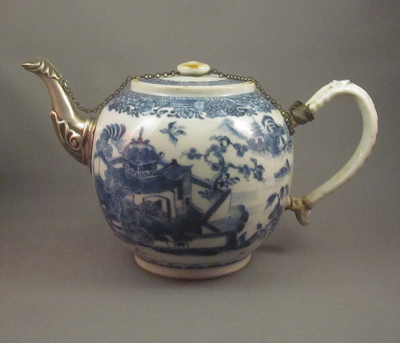



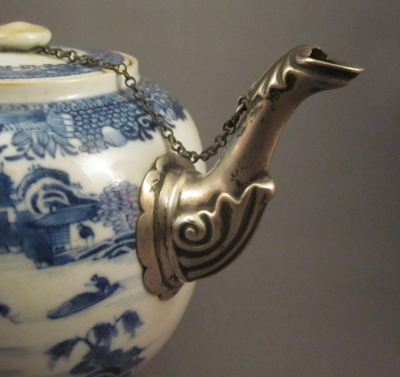

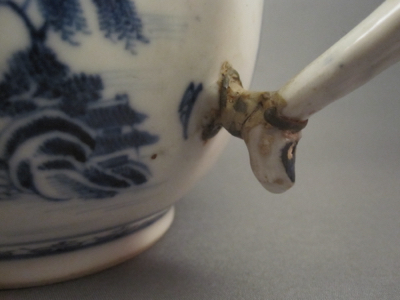
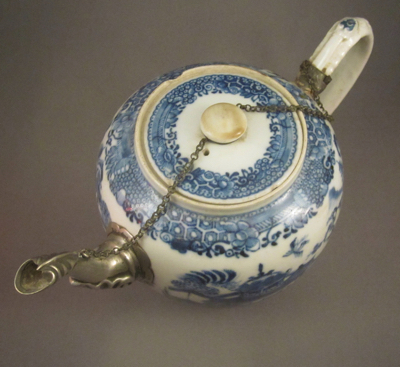
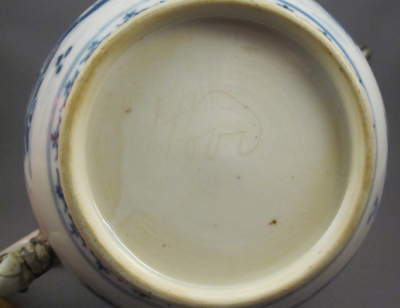
This teapot with similar form and decoration shows what the original spout on my teapot might have looked like.
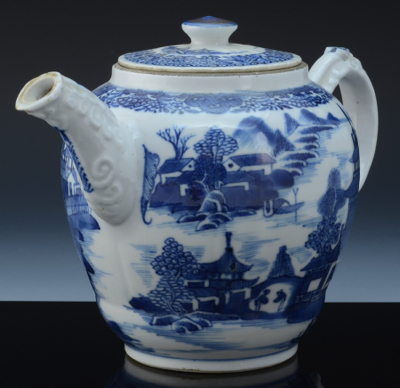
Photo courtesy of eBay
Tags:blue & white, Chinese, globular, metal spout, porcelain, silver
Posted in teapot | 2 Comments »
Sunday, December 7th, 2014
This small earthenware pottery teapot with squat round shape was made in England during the first quarter of the 19th century. It has a black glaze, aka Jackfiend and Egyptian black, and stands 4-1/2″ high. Due to its small size it is known as both a Bachelor’s and a one-cup teapot. Some collectors and dealers believe that these tiny teapots are miniatures or part of a child’s tea set, but they are actually functioning teapots.
By now my readers know that the main reason I purchased this teapot is due to its early replacement handle. Made by a tinker in the 19th century, the workmanship is a bit crude, as is evident by the malaligned horizontal band laden with excess soldier and the twisted wire support around the base. But even a funny looking tiny teapot with a clunky metal repair is better than burning your fingers on a teapot with no handle.

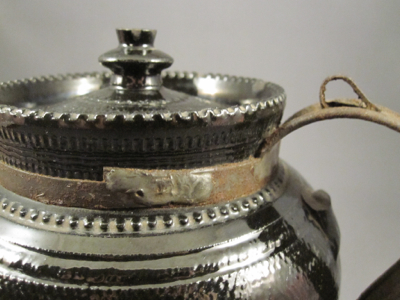
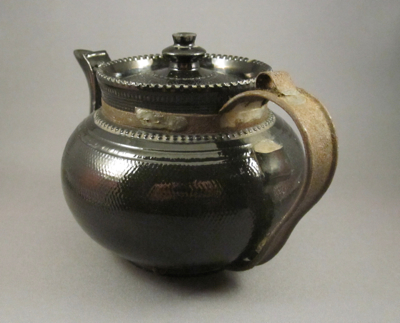


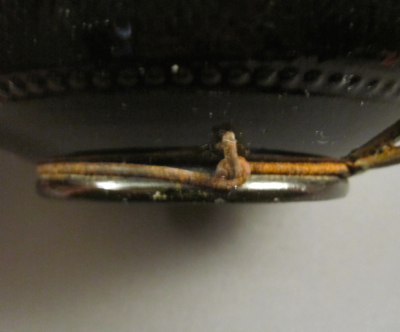
This teapot of similar form shows what the original handle on mine might have looked like.
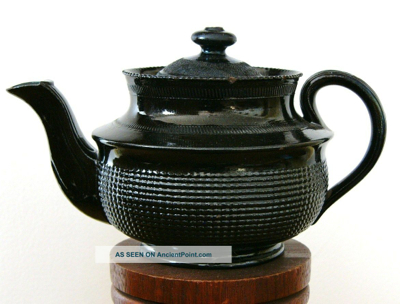
Photo courtesy of Ancient Point
Tags:basalt, English, metal spout, pottery, salt glaze
Posted in teapot | No Comments »
Sunday, October 26th, 2014
This small porcelain baluster shaped coffee pot with spreading foot was made in England by Worcester during the scratch cross period (1753-1755). It is decorated with Chinese figures, a parrot on a stand, furniture, and tea set; my favorite detail. Decorated in England, it copied the Mandarin style done by the Chinese, who themselves adapted European decoration for wares exported to North America and Europe. Marked on the underside with a scratch line and a painted anchor artist mark, this pot, minus its original lid, stands 5-3/4″ high.
Although the fragile and more apt to break “S” shaped handle with curled thumb rest remains intact, the original curved spout did not fare so well. A silversmith fashioned a fine silver spout with scalloped plate to replace the missing original. I have many examples of silver replacement spouts with the same form on pots in my collection, so I imagine this must have been a popular style used by silversmiths in the 18th and 19th century.

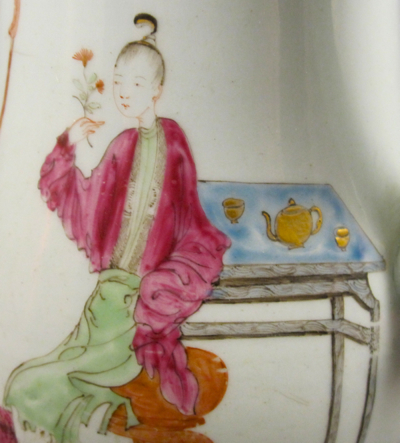
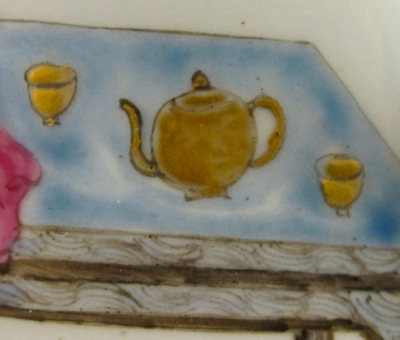
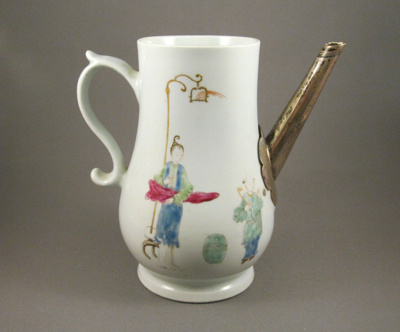
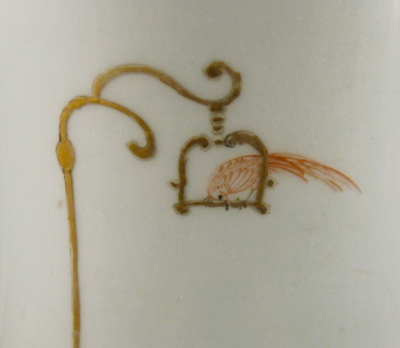
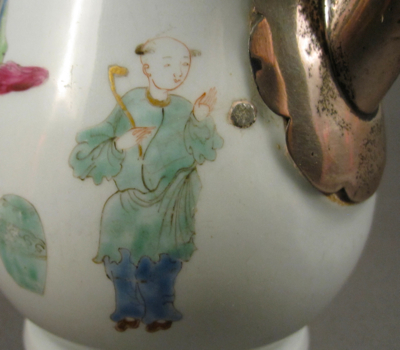

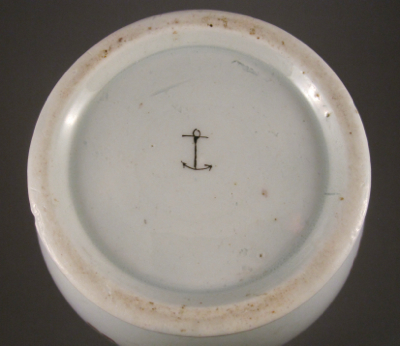
This is what a “perfect” example of the coffee pot and lid look like
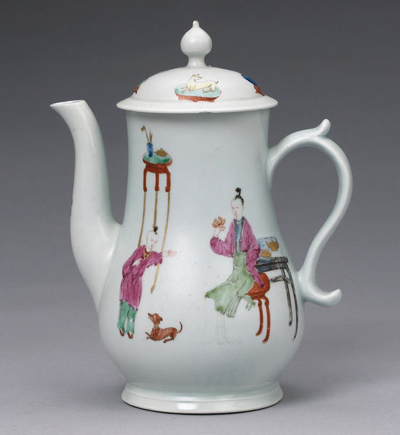
Photo courtesy of Bonhams
Tags:English, metal spout, porcelain, silver
Posted in chocolate/coffee pot | 1 Comment »
Saturday, September 13th, 2014
This Qianlong period globular form teapot has a C shaped handle and an inlaid flat lid with round knob. It was made in China in the mid-1700s and stands 4-1/4″ tall and 7-3/4″ from handle to spout. The original blue underglaze decoration fell out of fashion shortly after it was made, as by the mid-1700s more “attractive colors” were the taste of the day. In order to keep up with the sudden demand for polychrome Chinese ceramics, factories in Europe took the unwanted blue and white decorated pieces and overpainted them with brightly colored enamels, often without regard for the original design beneath. This victim of clobbering, as it is also referred to, or Amsterdam Bont, when done in Holland, has been over decorated with the flower basket motif, one of the most popular designs.
The unusual form replacement silver spout appears to have been made by a skilled 18th century silversmith. It replaced a straight spout, but I think this replacement is much more interesting, and adds to the quirkiness of this twice-decorated teapot.

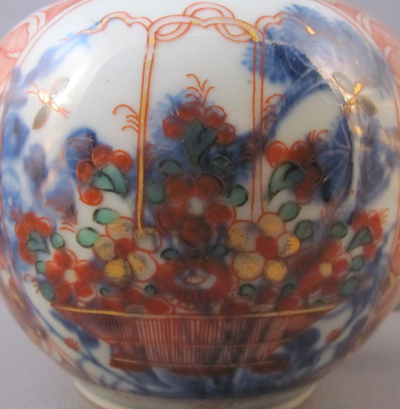


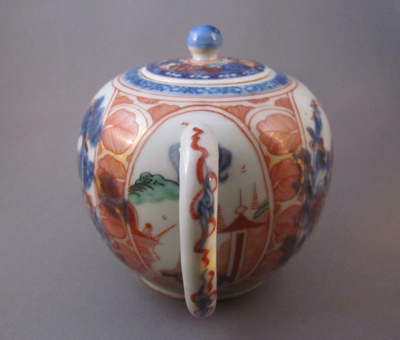
This teapot with similar form and decoration shows what the spout on my teapot might have looked like.
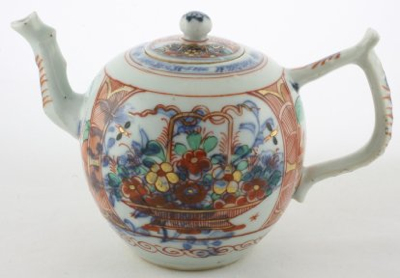
Photo courtesy of Pater Gratia Oriental Art
Tags:Chinese, clobbered, globular, metal spout, porcelain, Qianlong, silver
Posted in teapot | 1 Comment »
Saturday, August 9th, 2014
This large globular form porcelain teapot was made in China during the middle of the 18th century and has not one but two 19th century inventive repairs. It measures 6″ high and 9-1/2″ wide from handle to spout. Both sides have the same Mandarin decoration in the famille rose palette, depicting a family scene in a garden with trees and distant mountains.
But what makes this piece so special is the unusual shaped silver replacement spout with a heart shaped back plate and the overscaled wood replacement handle in silver mounts. I imagine the wood handle was intended for a larger teapot, but it might have been the only option available at the time of repair. I found this teapot in the UK and I have seen the same replacement spout on another teapot of the same period, also in the UK. Although most antiques collectors would rather have an example of this teapot in “perfect” condition, I much prefer the whimsy and uniqueness of this survivor with its quirky embellishments.






This teapot of similar form and decoration suggests what the original handle and spout on my teapot might have looked like.
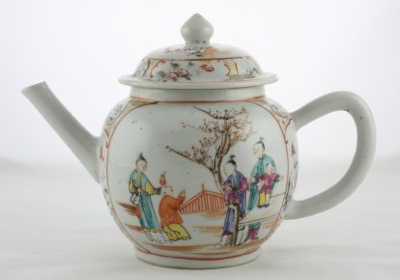
Photo courtesy of Pater Gratia Oriental Art
Tags:Chinese, Mandarin, metal spout, silver, wood handle
Posted in teapot | 8 Comments »



















































































